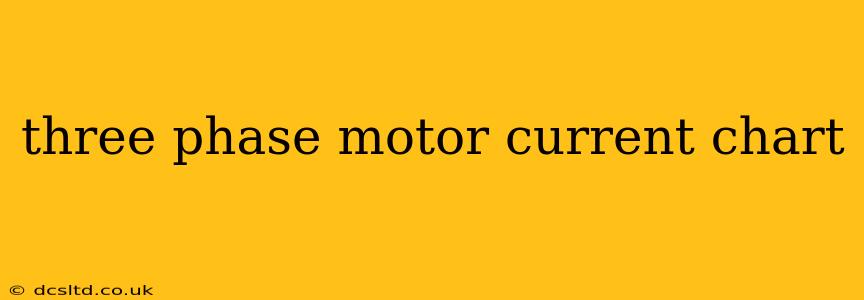Three-phase motors are workhorses in industrial and commercial settings, powering everything from conveyor belts to pumps. Understanding their current draw is crucial for efficient operation, preventative maintenance, and troubleshooting. This guide delves into interpreting three-phase motor current charts, explaining their significance and providing insights into common questions.
What is a Three-Phase Motor Current Chart?
A three-phase motor current chart visually represents the relationship between the motor's load and its current consumption. It typically plots the current (in amps) on the y-axis against the motor's percentage load or torque on the x-axis. These charts are specific to each motor model and are often found in the motor's data sheet or manufacturer's documentation. They're essential tools for:
- Predictive Maintenance: Identifying potential issues by monitoring current draw over time. An unexpected increase in current at a given load could indicate developing problems like bearing wear or winding faults.
- Load Optimization: Determining the optimal load for the motor to ensure efficient energy consumption and prevent overloading.
- Troubleshooting: Diagnosing motor issues by comparing the measured current to the values on the chart. Significant deviations may point to problems requiring attention.
- Sizing Electrical Systems: Ensuring that the electrical system (wiring, circuit breakers, etc.) can safely handle the motor's current draw under various load conditions.
What Information Can I Find on a Three-Phase Motor Current Chart?
A typical chart will display several key pieces of information:
- Full-Load Current (FLC): This is the current drawn by the motor when operating at its rated capacity (100% load). It's a critical parameter for selecting appropriate circuit breakers and wiring.
- Locked Rotor Current (LRC) / Starting Current: This is the significantly higher current drawn by the motor when it is initially started. This surge is temporary but crucial for sizing electrical systems to accommodate the start-up demand.
- Current at Various Load Percentages: The chart will show the current consumption at different load levels (e.g., 25%, 50%, 75%, 100%). This allows you to determine the current draw for specific applications.
- Motor Nameplate Data: The chart will often include the motor's nameplate data (voltage, horsepower, speed, etc.), ensuring clarity and correlation.
How Do I Interpret a Three-Phase Motor Current Chart?
Interpreting a three-phase motor current chart is straightforward:
- Identify the Load: Determine the percentage load your motor is operating under. This may involve measuring the mechanical output or using a motor load analyzer.
- Locate the Corresponding Current: Find the corresponding current value on the y-axis that intersects with your load percentage on the x-axis.
- Compare Measured Current: Compare the current value from the chart with the actual current measured using a clamp meter. Significant discrepancies could indicate a problem.
What Factors Affect Three-Phase Motor Current?
Several factors influence the current drawn by a three-phase motor:
- Load: The primary factor; higher load generally means higher current.
- Voltage: Lower voltage can lead to increased current draw.
- Power Factor: A lower power factor results in increased apparent current.
- Motor Efficiency: Less efficient motors draw more current for the same output.
- Temperature: Ambient temperature can affect the motor's resistance and thus its current draw.
How Do I Find a Three-Phase Motor Current Chart?
The most reliable source for a three-phase motor current chart is the motor's manufacturer. You can typically find it in:
- Motor's Data Sheet: This document provides comprehensive technical specifications, including the current chart.
- Manufacturer's Website: Many manufacturers make data sheets available for download from their websites.
What if I Cannot Find the Current Chart for My Motor?
If you cannot locate the chart, you may need to contact the motor's manufacturer directly or consult with an experienced electrical engineer. They may be able to provide the necessary information or suggest alternative methods for determining the motor's current draw under various load conditions. However, operating a motor without this data presents significant risks. Improper sizing of electrical components can lead to overheating, fire hazards, and premature equipment failure.
This comprehensive guide provides a solid foundation for understanding and utilizing three-phase motor current charts. Remember to always prioritize safety and consult with qualified professionals when dealing with high-voltage electrical equipment.
